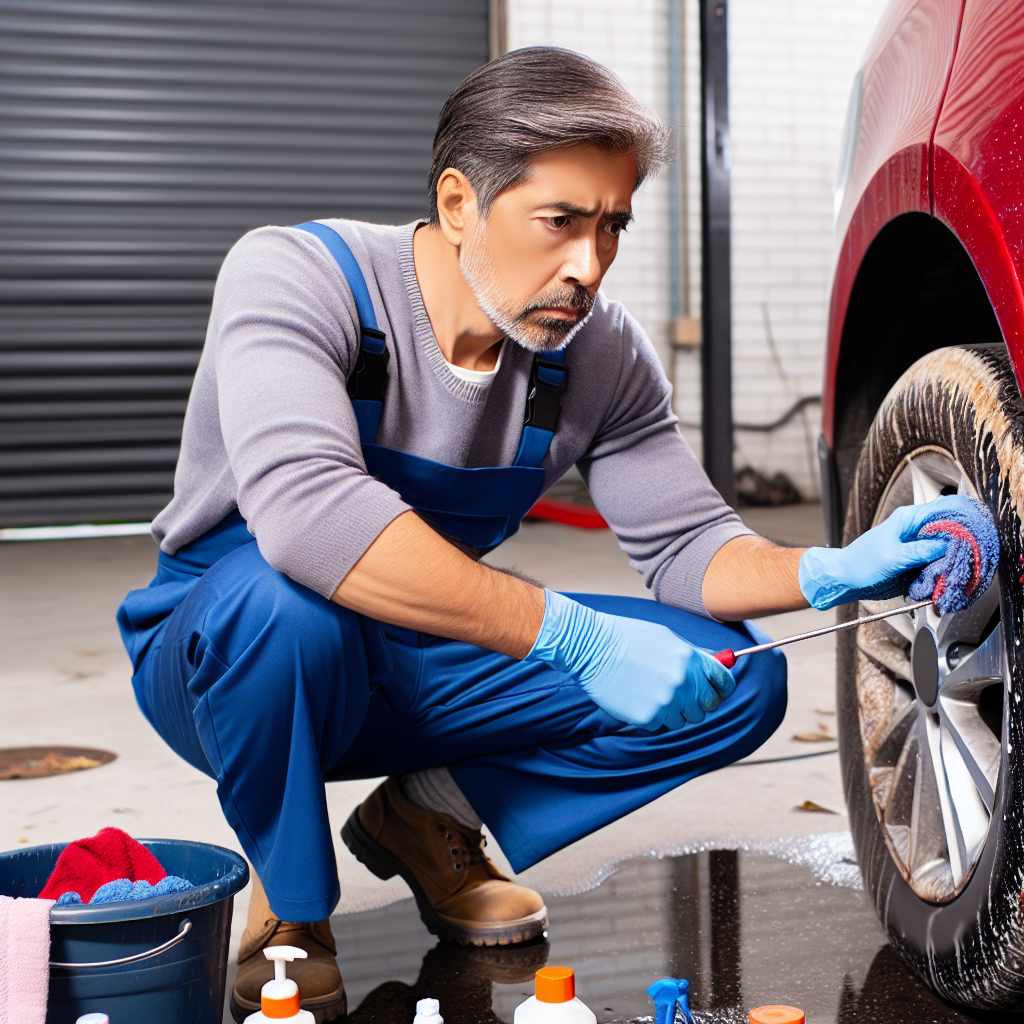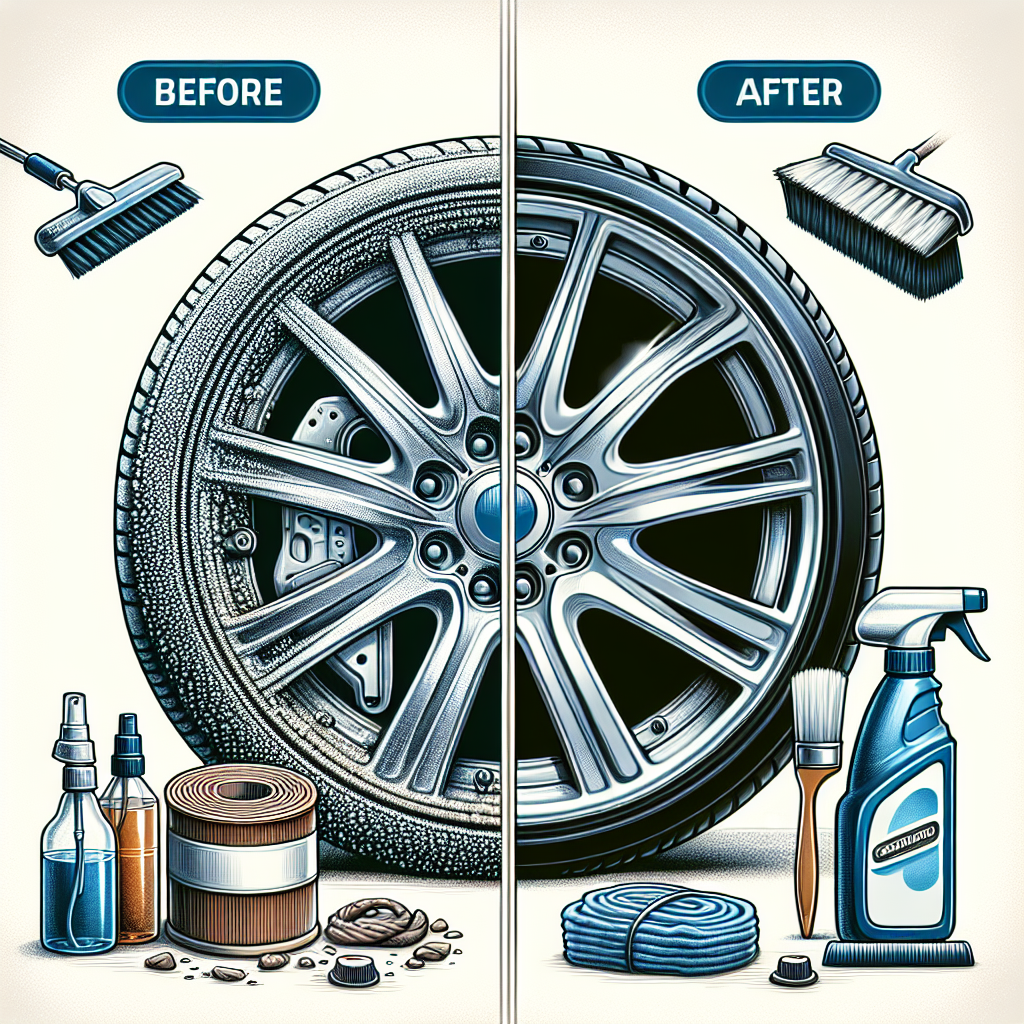If you find yourself facing those pesky, stubborn wheel stains that just refuse to go away, fear not! We’ve got you covered with some expert advice on how to tackle this frustrating problem. Don’t let those unsightly marks ruin the sleek appearance of your wheels any longer. With a few simple steps and the right tools, you’ll have your wheels looking shiny and brand new in no time. Say goodbye to those stubborn stains and hello to a set of wheels that will turn heads wherever you go.
Inspecting the Wheel Stains
When you encounter stubborn wheel stains, the first step is to inspect the stains closely to determine their type and severity. This will help you choose the most appropriate cleaning method. Take a close look at the stains and try to identify whether they are brake dust stains, rust stains, grease and oil stains, or tar and road paint stains.
Identifying the Type of Stain
To identify the type of stain on your wheels, consider the color and texture. Brake dust stains usually appear as a dark gray or black residue that adheres to the wheels. Rust stains, on the other hand, may appear as orange or brown spots and can be more challenging to remove. Grease and oil stains may have a slippery or slimy texture and can vary in color from black to brown. Tar and road paint stains are typically black and may feel sticky or hardened.
Determining the Severity of the Stain
After identifying the type of stain, assess the severity of the stains on your wheels. Determine whether the stains are superficial surface stains or deep-seated stains that have penetrated the wheel’s finish. This will help you determine the level of effort and appropriate cleaning techniques needed for effective stain removal.
Preparations before Cleaning
Before diving into cleaning your wheels, it’s essential to gather the necessary tools and materials to make the process easier and more efficient. You will need a bucket, mild soap or wheel cleaner, a soft brush or sponge, a pressure washer (optional), steel wool or sandpaper (only for specific cleaning techniques), chemical cleaners (as a last resort), gloves, and microfiber towels. Having all these materials on hand will ensure a smooth cleaning process.
Next, prepare a suitable cleaning area. It’s best to clean your wheels in a well-ventilated area, preferably outdoors, to minimize the spread of dirt and cleaning agents. Protect the surrounding area from potential splashes or overspray by using a tarp or an old sheet. This will help you maintain a clean and organized space for effective wheel cleaning.

General Cleaning Methods
Depending on the type and severity of the stains on your wheels, there are several general cleaning methods you can try. These methods include using a mild soap and water solution, applying commercial wheel cleaners, and trying household items as alternatives.
Using a Mild Soap and Water Solution
One of the simplest and most effective ways to clean your wheels is by using a mild soap and water solution. Fill a bucket with warm water and add a few drops of mild dish soap. Dip a soft brush or sponge into the soapy water and gently scrub the stains on your wheels. Rinse the wheels thoroughly with clean water and dry them with a microfiber towel. This method works well for removing light to moderate stains and is safe for most wheel finishes.
Applying Commercial Wheel Cleaners
Commercial wheel cleaners are specifically formulated to tackle tough stains, including brake dust and grease. These cleaners often come in spray bottles or aerosol cans for easy application. To use a commercial wheel cleaner, spray it onto the stained areas of your wheels and let it sit for the recommended amount of time specified on the product instructions. Use a soft brush or sponge to agitate the cleaner and loosen the stains. Rinse the wheels thoroughly and dry them with a microfiber towel. Be sure to follow the manufacturer’s instructions and use caution when using these cleaners, especially on delicate or custom wheels.
Trying Household Items as Alternatives
If you prefer a more budget-friendly approach or don’t have access to commercial wheel cleaners, you can try using household items as alternatives. Baking soda mixed with water to form a paste can be effective for removing brake dust stains. Apply the paste to the stains, let it sit for a few minutes, and then scrub with a soft brush or sponge. Rinse thoroughly and dry. Another household alternative is using vinegar or lemon juice diluted with water. These natural acids can help break down grease and oil stains. Apply the solution to the stains, scrub gently, and rinse well.

Specific Cleaning Techniques
In addition to the general cleaning methods, there are specific cleaning techniques you can employ to address different types of wheel stains. These techniques include using a soft brush or sponge, pressure washing, utilizing steel wool or sandpaper, and using chemical cleaners as a last resort.
Using a Soft Brush or Sponge
A soft brush or sponge is essential for scrubbing away stains without damaging the wheel’s finish. When using this technique, dip the brush or sponge into your chosen cleaning solution and gently scrub the stained areas in a circular motion. Take care not to apply too much pressure, as this can scratch the wheels. Rinse the wheels thoroughly with clean water after scrubbing and dry them with a microfiber towel.
Applying Pressure Washing
If your wheels have heavy stains or are difficult to clean with a brush or sponge alone, you can use a pressure washer. Ensure you use a pressure washer with an appropriate nozzle and pressure setting to avoid damaging the wheels or their finish. Start by rinsing the wheels to remove loose dirt and debris, then apply your chosen cleaning solution. Hold the pressure washer nozzle a safe distance away from the wheels and spray in a sweeping motion, focusing on the stained areas. Rinse thoroughly with clean water and dry with a microfiber towel.
Utilizing Steel Wool or Sandpaper
For stubborn stains that are deeply embedded in the wheel’s surface, you may need to use more aggressive measures. Steel wool or fine-grit sandpaper can be used to gently buff away these stains. Wet the surface of the wheel, and then use the steel wool or sandpaper to rub the stains in a circular motion. Take care not to apply too much pressure to prevent scratching the wheel’s finish. Once the stains are removed, rinse thoroughly and dry.

Using Chemical Cleaners as a Last Resort
If all else fails, chemical cleaners can be used as a last resort. However, exercise caution when using chemical cleaners, as they can be harsh and potentially damage your wheels’ finish. Follow the manufacturer’s instructions carefully and wear gloves for protection. Apply the chemical cleaner to the stains, let it sit for the recommended time, and scrub gently with a soft brush or sponge. Rinse thoroughly with clean water and dry with a microfiber towel.
Removing Brake Dust Stains
Brake dust stains are a common issue, especially on wheels with high-performance brakes. To effectively remove brake dust stains, it’s important to take preventive measures and use suitable cleaning methods.
Preventing Brake Dust Build-up
One way to address brake dust stains is by preventing their build-up in the first place. Adding wheel sealants or ceramic coatings can create a protective barrier on the wheel’s surface, making it easier to clean off brake dust. Regularly cleaning your wheels and applying these protective coatings can significantly reduce the chances of brake dust stains forming.
Applying an Acid-Based Cleaner
If you notice stubborn brake dust stains on your wheels, an acid-based cleaner can be effective in breaking down the residue. It’s important to use an acid-based cleaner specifically designed for wheels and follow the instructions carefully to avoid damaging the wheels or their finish. Apply the cleaner to the stained areas, let it sit for the recommended time, and use a soft brush or sponge to scrub away the brake dust. Rinse thoroughly and dry.

Using a Non-Acidic Cleaner
For those who prefer a less aggressive approach, a non-acidic cleaner can also be used to remove brake dust stains. These cleaners are specifically formulated to break down and lift brake dust without containing harsh chemicals. Apply the non-acidic cleaner to the stains, let it sit for a few minutes, and scrub gently with a soft brush or sponge. Rinse thoroughly and dry.
Dealing with Rust Stains
Rust stains on wheels can be particularly stubborn and challenging to remove. However, with the right techniques and products, you can effectively tackle these stains and restore your wheels’ appearance.
Removing Light Surface Rust
For light surface rust stains, you can use a mild acid or rust remover specifically designed for automotive use. Apply the product to the stained areas, let it sit for the recommended time, and scrub gently with a soft brush or sponge. Rinse thoroughly and repeat the process if necessary. Once the stains are removed, rinse thoroughly with clean water and dry.
Treating Deep-seated Rust Stains
Deep-seated rust stains require a more aggressive approach. In these cases, you may need to use steel wool or sandpaper to remove the stains. Wet the surface of the wheel, then gently rub the stains with the steel wool or sandpaper in a circular motion. Be cautious not to apply too much pressure to avoid damaging the wheels. Rinse thoroughly with clean water and dry. After removing the rust stains, it’s crucial to apply a protective coating or wax to prevent future rust formation.

Addressing Grease and Oil Stains
Grease and oil stains on your wheels can not only be unsightly but also pose a safety hazard. It’s important to address these stains promptly using appropriate techniques.
Absorbing Excess Grease or Oil
Before applying any cleaning solutions, it’s essential to absorb excess grease or oil from the stains. Use paper towels or absorbent materials to blot the stains gently. Avoid rubbing the stains, as this can spread the grease or oil and make the cleaning process more difficult.
Using Degreasers for Stubborn Stains
When it comes to stubborn grease and oil stains, degreasers can be highly effective. Choose a wheel-specific degreaser or a multi-purpose automotive degreaser. Spray or apply the degreaser to the stained areas and let it sit for the recommended time. Then, use a soft brush or sponge to scrub the stains gently. Rinse thoroughly with clean water and dry.
Treating Tar and Road Paint Stains
Tar and road paint stains can be particularly challenging to remove, as they often stick firmly to the wheel’s surface. However, with the right techniques and tools, you can successfully tackle these stains.
Loosening Tar and Softening Road Paint
To loosen tar and soften road paint stains, you can use a tar and adhesive remover specifically designed for automotive use. Apply the remover to the stained areas and let it sit for a few minutes. Use a soft brush or sponge to gently scrub the stains, working in small circular motions. Rinse thoroughly with clean water.
Carefully Scraping off the Stains
For more stubborn tar and road paint stains, you may need to carefully scrape them off. Use a plastic scraper or a plastic credit card to avoid scratching the wheel’s surface. Take care not to apply too much pressure to prevent damage. Once you’ve scraped off the stains, use a mild soap and water solution or a suitable wheel cleaner to remove any residue. Rinse thoroughly and dry.
Refinishing or Polishing Wheels
In some cases, your wheels may require refinishing or polishing to restore their appearance and protect them from future stains or damage. Understanding the need for refinishing and choosing the appropriate method is crucial for achieving the desired results.
Determining the Need for Refinishing
If your wheels have deeper scratches, gouges, or areas where the finish has worn off, refinishing may be necessary. Inspect your wheels closely, looking for signs of damage or deterioration. If the damage is severe or if refinishing is desired for purely aesthetic purposes, it may be best to seek professional assistance or consult a wheel refinishing specialist.
Selecting the Appropriate Refinishing Method
There are various refinishing methods available, depending on the type of wheels and the extent of the damage. These methods include sanding and repainting, powder coating, or even replacing the wheels altogether. It’s important to thoroughly research and consider the best option for your specific needs before proceeding with any refinishing method.
Polishing the Wheels for a Sleek Look
If your wheels are in good condition but lack the desired shine and luster, polishing them can enhance their appearance. Polishing wheels can effectively remove minor scratches, swirl marks, and oxidation. Use a suitable wheel polish and apply it to the wheels using a clean microfiber cloth. Work in small circular motions, and ensure complete coverage. Once you’ve polished the wheels, buff them with a separate clean microfiber cloth to reveal a sleek, glossy finish.
Regular Wheel Maintenance
To keep your wheels looking their best and prevent the build-up of stubborn stains, it’s crucial to establish a regular wheel maintenance routine. This routine should include regular cleaning, using wheel sealants for protection, and inspecting and maintaining tire pressure.
Regularly Cleaning Wheels
Make it a habit to clean your wheels regularly to prevent the build-up of brake dust, grease, oil, and other contaminants. By cleaning your wheels at least once a month or more frequently if needed, you can reduce the chances of stubborn stains forming and maintain their appearance. Follow the general cleaning methods mentioned earlier to effectively remove dirt and stains, ensuring your wheels always look their best.
Using Wheel Sealants for Protection
Applying wheel sealants is an effective way to protect your wheels from various contaminants and make cleaning easier. Wheel sealants create a protective layer on the wheel’s surface, preventing brake dust and other stains from adhering. Before applying a wheel sealant, thoroughly clean and dry your wheels. Follow the manufacturer’s instructions and apply the sealant evenly using a clean microfiber cloth. Allow the sealant to cure before driving your vehicle.
Inspecting and Maintaining Tire Pressure
Regularly inspecting and maintaining tire pressure is not directly related to removing stubborn wheel stains but is an essential part of overall wheel maintenance. Improperly inflated tires can cause uneven wear on the wheels and potentially impact their appearance. Use a tire pressure gauge to check the tire pressure regularly, and inflate or deflate them as needed to maintain the recommended pressure levels. By keeping your tires properly inflated, you can ensure that your wheels maintain proper contact with the road and reduce the risk of damage or premature wear.
In conclusion, encountering stubborn wheel stains can be frustrating, but with the right techniques and products, you can effectively remove them and restore your wheels’ appearance. By following the outlined inspection process and utilizing suitable cleaning methods, you’ll be able to tackle brake dust stains, rust stains, grease and oil stains, and tar and road paint stains. Additionally, addressing the need for refinishing or polishing, establishing a regular wheel maintenance routine, and maintaining proper tire pressure will help keep your wheels looking their best in the long run. Remember to take your time, follow the instructions carefully, and prioritize the preservation of your wheels’ finish throughout the cleaning and maintenance process. With a friendly and diligent approach, you can confidently handle stubborn wheel stains and enjoy the satisfaction of clean, gleaming wheels on your vehicle.

